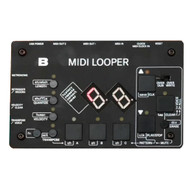BASTL Instruments — MIDI Looper
by Brandon Ivers
Bastl Instruments, based out of the Czech Republic, have been around since 2013, but their profile has risen significantly in the last few years due to a string of odd yet imaginative instruments and effects. Bastl’s latest, the MIDI Looper, continues their explorations of strange but immediately useful music “things” by giving us a thing we never knew we needed: a... MIDI looper. Yes, it does exactly what the title suggests plus a bit more, and it’s very addictive once you realize how simple and fast the workflow is.
The MIDI Looper has a single MIDI input, two MIDI outputs, and several analog inputs [clock, reset, transpose, and more] for modulating or controlling the looper. At the Looper’s most basic, you connect a sequencer or MIDI controller to the MIDI input, connect various pieces of gear to the Looper’s two MIDI outputs, hit the record button, and start playing some stuff. You hit the record button again to end the loop. A green light tells you that the loop has been captured and the length has been set, after which you can start playback of your loop.
I initially tested out the MIDI Looper with a Yamaha digital piano, which happened to have MIDI in and outs. I was surprised to find that the piano transmitted MIDI clock, so I was able to clock the MIDI Looper with the piano and play with the piano’s metronome. I hit record, played some chords, and hit record again. That was it, the part I played on the piano looped as I played it. Much like working with an audio looper, the workflow is absurdly simple and fast for getting ideas out. However, the MIDI Looper has some additional tricks an audio looper does not.
As mentioned previously, the MIDI Looper has several analog inputs for modulating the looper. One of the inputs is transpose, meaning that you can easily transpose your loop via CV [1 volt per octave]. You can also transpose the loop by hitting the transpose button and playing a key on your keyboard, much like on the Arturia Keystep’s sequencer mode. Beyond transpose, you can quantize your loop, with selectable divisions such as 16th notes and sextuplets. You can also stretch the loop at either double or half speed, filter note velocities to a static value, add shuffle and humanization, and change the loop length on the fly. With these various transformations, the MIDI Looper is almost like a mini sequencer. There are three channels of looping available as well, so you can actually get some polyrhythmic patterns going as each channel can have different lengths, etc.
After playing around with some of the MIDI Looper’s transformation functions, I decided to make my second outing a bit more complicated. First, I hooked up an Arturia Keystep to the MIDI input. I then hooked up my modular [via a MIDI module] up to one of the MIDI Looper’s outputs, and a Roland TR-8 to the other output. The Keystep provided the master clock and I could start everything with its play button. As I was playing notes on the Keystep and looping notes sent to the modular, much like how I did with the digital piano, I tried using the mod wheel control on the Keystep. I was pleasantly surprised to find the MIDI Looper captured and looped my movements there as well. This made me realize another cool trick: the MIDI Looper can also loop MIDI CC values—a very cool bonus.
Obviously, the MIDI Looper is not going to replace a good sequencer or a DAW or anything like that. I want to stress again that it’s really not a sequencer in any traditional sense, despite having sequencer-like functions, not to mention there are only twelve slots to save loops in. But it is fast, simple, and cheap, and I suspect some people will find it a much better way to just jam and find happy accidents. I certainly found that to be the case. Highly recommended if you’re trying to simplify your workflow and/or get away from menu-diving outside of the computer.
Price: €239


